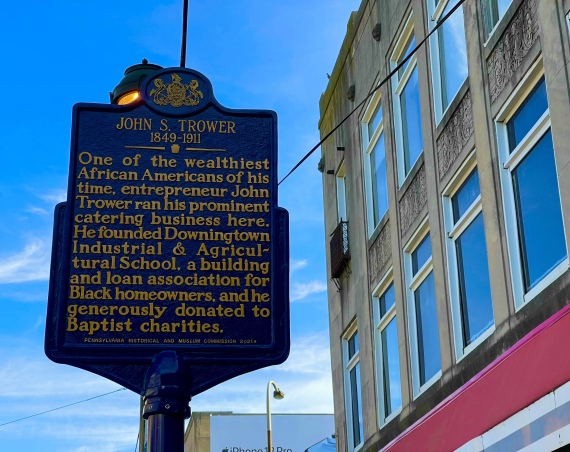
What do Philadelphia and New York City have in common? According to one Brooklyn native, they are both a city of beautiful eclectic neighborhoods. And while each city has its own established cultures, they are similar because the communities within have their own “precedent” and “structure,” meaning that no two neighborhoods are the same. That made Monica O. Montgomery fall in love with Philadelphia during her time as an undergraduate at Temple University. But, it was her growing relationship with Germantown that made Montgomery feel like she was home. Years later, she has returned to “Freedom’s Backyard” as the new Director of Community Engagement and Programs for Historic Germantown with a one-of-a-kind experience that will support her in the new role.
According to the website, Historic Germantown is “a partnership of 18 extraordinary historic houses, destinations, and museums in Northwest Philadelphia that have joined together to protect, preserve, and share some of Philadelphia’s prized historical assets.” This partnership includes places like the Germantown White House, where President George Washington both lived and vacationed, and the Cliveden House, which sheltered British troops during the Battle of Germantown in 1777.
Montgomery got her first taste of Germantown when she attended La Salle University, earning her Master’s degree in Corporate Communication. As a Lasallian, she started understanding the northwest section of Philadelphia more and its neighborhoods. She came across the Mt. Airy Learning Tree, a community-based nonprofit organization in Mt. Airy that provides educational and recreational opportunities to strengthen and enrich the diverse community of Northwest Philadelphia.
She reflects on her time at the center, saying that while she was studying at La Salle, “taking courses at Mt. Airy Learning Tree was the catalyst that sparked [her] nonprofit career.”
But, Monica’s connection to this side of town didn’t stop after her time at La Salle or the Learning Tree. After frequenting places in the Northwest area, like the no-longer operating Chef Ken’s, she got a job in Germantown. She became the Director of Communications and Fundraising for the Greene Tree School, which serves children on the Autism spectrum. She also lived in the Emperian Luxury Towers on Rittenhouse and Wissahickon. She says that recalling the “green, lush, historic environment” with “friendly” people had always made her remember she had to get back to the neighborhood after being let go from her job because of the 2007-09 recession. That led Montgomery to a different path, where she decided she would take her polished communication skills into a new profession — teaching.
Montgomery already had relations to the profession, as her father is a college professor and her mother is a school assistant principal. At that time in her life, she yearned to help people more directly, and she said, “what better way than with babies in the classroom?” She said that teaching for the school was fantastic, but the ruthless killing of Trayvon Martin changed her trajectory. She was now dealing with teaching her students of ages three and four their ABCs and 123s and navigating conversations around social injustice.
She recalls how impactful this moment was for people of all ages. These young people, who were still developing crucial social and educational skills, were already noticing the world’s wrongs. They would ask her things like, “Is it illegal to eat Skittles?” “Are we in trouble?” and even ask if they would be harmed for wearing hoodies. She felt the need to do something.
“For three- and four-year-olds to be saying this means that they’re responding to the angst in the atmosphere and what they’re hearing on the news and from snippets of their parents’ conversations,” said Montgomery to explain how children so young would voice such questions. “And I felt so anguished because I didn’t know how to console and comfort them.”
Those interactions led her to create a curriculum and lesson plan around community care and what it looks like to explain racial injustices to young minds in an early childhood setting. She wanted them to understand terms around stereotypes and prejudice and make sure their interactions were colorful and alive. And they did — and it was. Students did a lot of service-learning and conversing around Black lives and safety topics and even sent Trayvon Martin’s mom Mother’s Day cards. But while her intentions were rooted in care and change-making, the school did not share the same vision.
Montgomery says that the principal called her to the office one day for what she thought was to ask her to sign on for the next year, but it was precisely the opposite. The principal told Montgomery that her methods were too radical and that no one had hired her to be an activist, so she would have to find a new place of employment. Monica was shocked, as none of the staff had shown her any dismay during the entire year. And while her feelings of betrayal around the school system were substantial, she felt even stronger about her convictions on how education and social justice could be merged.
She posed the question to herself, “if we can’t talk about the world and current events and truth and justice in a classroom, where can we do it?” Answering that question shifted her career once more into the world of museums.
Montgomery believes that museums are a place for “informal learning, enrichment, art, culture, and dialogue.” Holding the belief that museums should be in public service to society, she leads her work as a social justice museum leader by examining what is wrong and calling forth community voices and how those things can be made right. She feels that museums can be more than just a place where people gather to see incredible things; as conveners, museums can birth transformation, encouragement, and connection. She put theory into practice by curating more than 40 different exhibits and festivals around the country on themes like Black Lives Matter, feminism, climate change, the school-to-prison pipeline, and many more at various venues, including laundromats, parks, homeless shelters, and museums with physical locations like the Brooklyn Museum, The New School, The South African Embassy, The High Line, and many more. That work led Montgomery to lead the Prince George’s African American Arts and Culture Center in Prince George’s County, Maryland, where she became the executive director. She did that until the coronavirus pandemic struck and was later invited to join the Smithsonian Arts and Industries building as their social justice curator for the blockbuster FUTURES exhibition, showing through summer 2022.
Monica now re-enters Germantown, optimistic that her skills as a communicator and curator will boost the fantastic work that is already happening in the neighborhood. She says, “I want the world to know about Germantown — an area where history, nature, and culture are literally on every corner.” The new director feels that holding a mirror up to the neighborhood is the only impact she wishes to have on the community, saying what she wants to do the most in the coming months is just to listen and explore. She is honored to be able to “advise on a racial equity strategy on how museums within the Historic Germantown consortium can respond and take action around Black Lives Matter and adjacent local movements.”
She encourages neighbors to explore and experience the happenings of Historic Germantown, highlighting that there are a wide variety of things that folks can do besides going into the museums like having a picnic on the green spaces, attending one of six festivals throughout the year, and volunteering at events.
Montgomery is working alongside the historic sites to get the word out about the dynamic cultural tourism Historic Germantown has to offer; the local museums, heritage tours, author talks, food tastings, architectural marvels, burial grounds, hall of fame heroes, greenspace parks, festivals and diverse programs that makes up Freedoms Backyard! She shares that her favorite thing (if she had to choose) about the neighborhood is the rich presence of the Black community.



